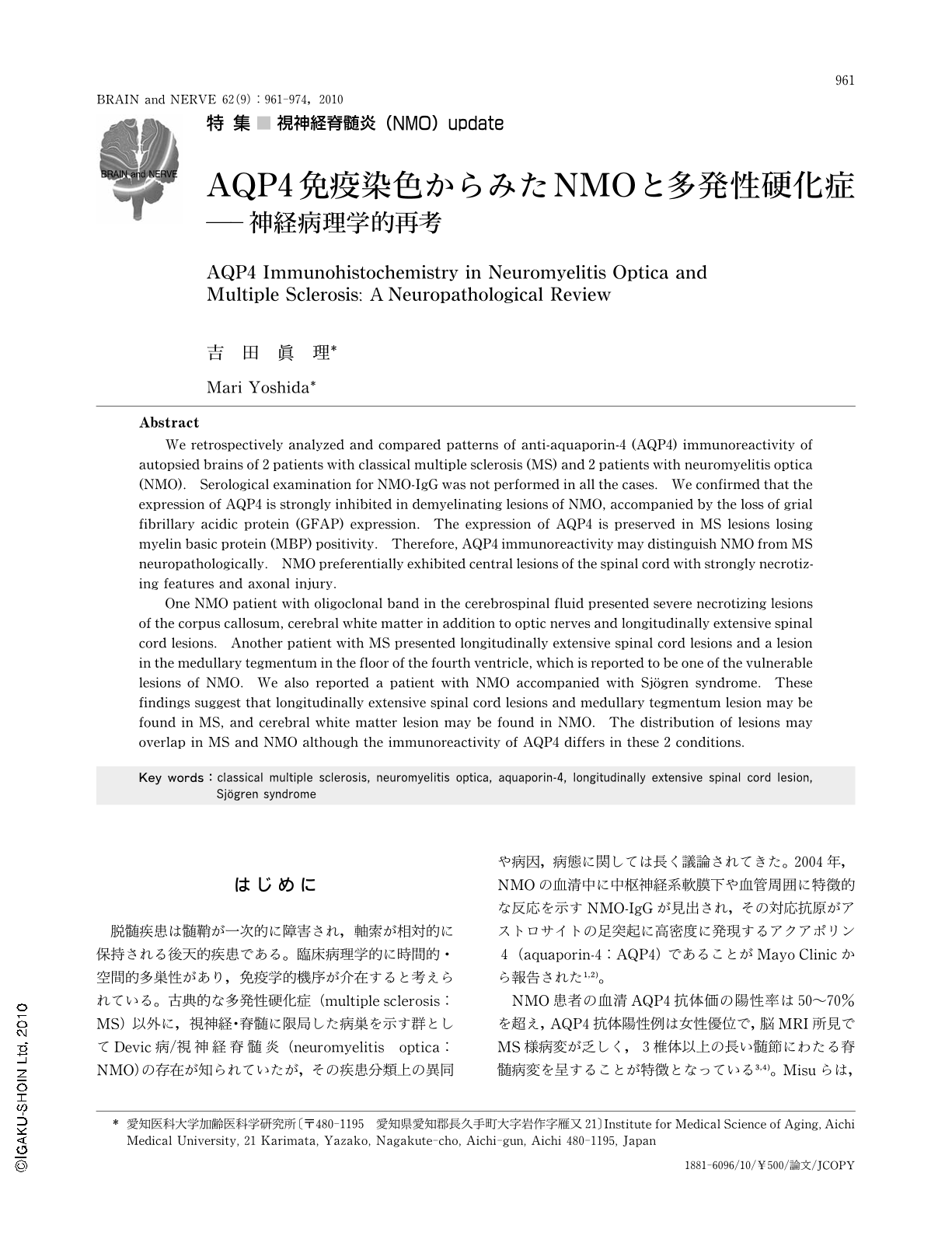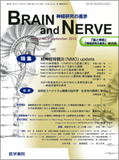Japanese
English
- 有料閲覧
- Abstract 文献概要
- 1ページ目 Look Inside
- 参考文献 Reference
- サイト内被引用 Cited by
はじめに
脱髄疾患は髄鞘が一次的に障害され,軸索が相対的に保持される後天的疾患である。臨床病理学的に時間的・空間的多巣性があり,免疫学的機序が介在すると考えられている。古典的な多発性硬化症(multiple sclerosis:MS)以外に,視神経・脊髄に限局した病巣を示す群としてDevic病/視神経脊髄炎(neuromyelitis optica:NMO)の存在が知られていたが,その疾患分類上の異同や病因,病態に関しては長く議論されてきた。2004年,NMOの血清中に中枢神経系軟膜下や血管周囲に特徴的な反応を示すNMO-IgGが見出され,その対応抗原がアストロサイトの足突起に高密度に発現するアクアポリン4(aquaporin-4:AQP4)であることがMayo Clinicから報告された1,2)。
NMO患者の血清AQP4抗体価の陽性率は50~70%を超え,AQP4抗体陽性例は女性優位で,脳MRI所見でMS様病変が乏しく,3椎体以上の長い髄節にわたる脊髄病変を呈することが特徴となっている3,4)。Misuらは,NMOの急性期の病巣でAQP4の発現が欠損していること,NMOの病変部では補体であるC9neoの沈着する血管周囲のAQP4やGFAP(grial fibrillary acidic protein)の染色性が低下し,また急性期NMO病巣では,AQP4の欠落に比して髄鞘蛋白であるミエリン塩基性蛋白(myelin basic protein:MBP)は保たれているのに対して,MSではMBPの染色性は消失するがAQP4の発現は反応性アストロサイトとともに発現が亢進することを報告した5)。これらの所見から,AQP4がNMOの病態に深く関与し,MSとNMOが異なる機序をもつ疾患であることが明白となった。本稿では,AQP4の免疫染色がMSとNMOの鑑別となり得るかという視点から,愛知医科大学加齢医科学研究所の脱髄疾患の剖検例を再検討した中から代表的な症例を紹介する。コントロール脊髄のAQP4免疫染色では中心管近傍から灰白質に豊富に発現し,白質では軟膜直下および血管周囲のVirchow-Robinの足突起に陽性像を認めた(Fig.1)。剖検例の後方視的な再検討であり,血清AQP4抗体価は測定されていない時代の症例の病理像のみからの予備的検討という制約があるが,MSやNMOの新たな理解の一助となれば幸いである。
Abstract
We retrospectively analyzed and compared patterns of anti-aquaporin-4 (AQP4) immunoreactivity of autopsied brains of 2 patients with classical multiple sclerosis (MS) and 2 patients with neuromyelitis optica (NMO). Serological examination for NMO-IgG was not performed in all the cases. We confirmed that the expression of AQP4 is strongly inhibited in demyelinating lesions of NMO, accompanied by the loss of grial fibrillary acidic protein (GFAP) expression. The expression of AQP4 is preserved in MS lesions losing myelin basic protein (MBP) positivity. Therefore, AQP4 immunoreactivity may distinguish NMO from MS neuropathologically. NMO preferentially exhibited central lesions of the spinal cord with strongly necrotizing features and axonal injury.
One NMO patient with oligoclonal band in the cerebrospinal fluid presented severe necrotizing lesions of the corpus callosum,cerebral white matter in addition to optic nerves and longitudinally extensive spinal cord lesions. Another patient with MS presented longitudinally extensive spinal cord lesions and a lesion in the medullary tegmentum in the floor of the fourth ventricle,which is reported to be one of the vulnerable lesions of NMO. We also reported a patient with NMO accompanied with Sjögren syndrome. These findings suggest that longitudinally extensive spinal cord lesions and medullary tegmentum lesion may be found in MS,and cerebral white matter lesion may be found in NMO. The distribution of lesions may overlap in MS and NMO although the immunoreactivity of AQP4 differs in these 2 conditions.

Copyright © 2010, Igaku-Shoin Ltd. All rights reserved.


